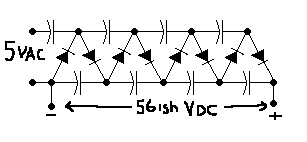I was wondering about the possibilites of using a charge pump/s to derive a bias/switching supply from a 5v tap. Anyone ever experimented with this sort of thing? Dumb idea? Are there even any practical circuits that could do this?
It would have to be a voltage octupler at least to get to 40v and I'm guessing 10mA rating minimum although I guess I really don't know how much current your typical bias supply draws.
I suppose there is the diode/cap ladder multiplier but then you're talking about adding 8 more e-lytics to the circuit.
Just kinda thinking out loud here.
It would have to be a voltage octupler at least to get to 40v and I'm guessing 10mA rating minimum although I guess I really don't know how much current your typical bias supply draws.
I suppose there is the diode/cap ladder multiplier but then you're talking about adding 8 more e-lytics to the circuit.
Just kinda thinking out loud here.



Comment